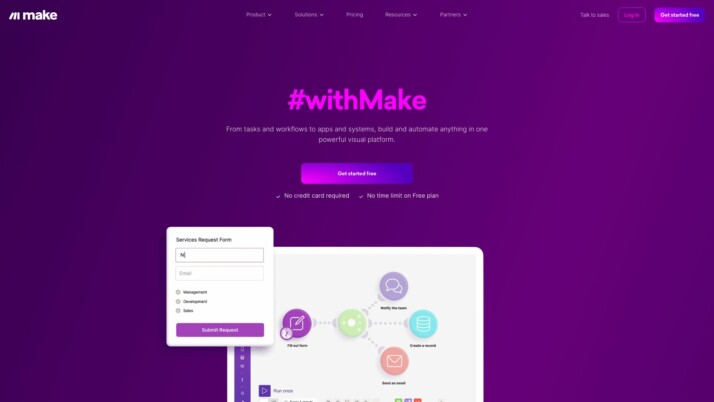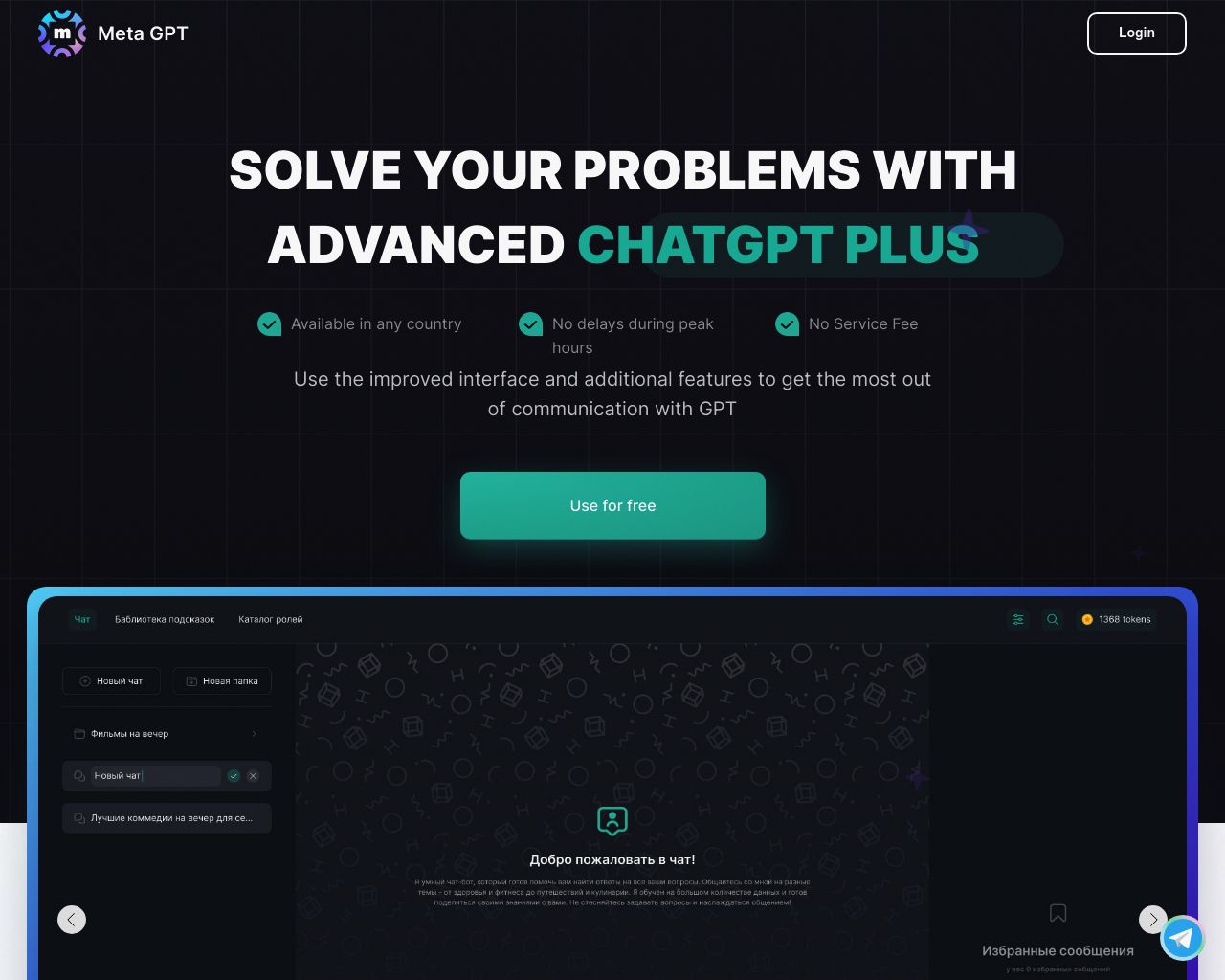Make.com vs. MetaGPT: Comparing Workflow Automation and AI Development
AI agent builders and workflow automation platforms transform how businesses operate in today’s digital landscape. This comparison explores Make.com’s visual automation platform, MetaGPT’s innovative AI-driven software development framework, and SmythOS’s comprehensive AI agent solution.
We’ll examine their unique approaches to workflow automation, AI collaboration, and software development, highlighting key features, strengths, and limitations. By the end, you’ll understand which platform best suits your needs for streamlining processes, enhancing productivity, and leveraging AI capabilities in your organization.
Make.com Overview
Make.com delivers a powerful visual automation platform for connecting apps and streamlining workflows without coding. The intuitive drag-and-drop interface allows users to build complex scenarios by linking over 1000 popular apps and services. Make.com excels at empowering non-technical users to create sophisticated integrations that automate repetitive tasks and data flows across systems.


Make.com’s visual builder enables rapid scenario creation through a flowchart-like canvas. Users can drag and drop modules representing different apps, then configure the data passing between them using simple drop-down menus and mapping tools. This approach makes automating multi-step processes involving multiple services accessible to users without programming skills.
Make.com delivers a powerful visual automation platform for connecting apps and streamlining workflows without coding. The intuitive drag-and-drop interface allows users to build complex scenarios…
While Make.com lacks AI agent capabilities, it provides robust tools for data transformation, conditional logic, and error handling within automated workflows. The platform offers detailed execution logs, scheduled runs, and collaboration features for teams. Make.com’s enterprise-grade security, scalability, and integration ecosystem make it suitable for organizations of all sizes seeking to boost productivity through automation.
However, Make.com’s focus on app integration and workflow automation means it has limitations for users seeking to build true AI agents or leverage advanced machine learning capabilities. The platform does not offer features like natural language processing, computer vision, or autonomous decision-making that define leading AI agent builders. For users prioritizing these AI-centric capabilities, alternative platforms may be more suitable.
MetaGPT Overview
MetaGPT revolutionizes multi-agent collaboration by fusing human Standardized Operating Procedures (SOPs) with advanced Large Language Models (LLMs). This open-source framework simulates a software company’s structure, assigning distinct roles like product managers, architects, and engineers to AI agents.


MetaGPT’s core philosophy, “Code = SOP(Team),” integrates established human practices into AI-driven processes. This approach enables the platform to tackle complex software development tasks, producing coherent, high-quality code while minimizing errors typically associated with multi-agent systems.
MetaGPT revolutionizes multi-agent collaboration by fusing human Standardized Operating Procedures (SOPs) with advanced Large Language Models (LLMs).
The framework stands out with its assembly line paradigm, breaking tasks into manageable subtasks handled by specialized agents. This method ensures each agent contributes its expertise, resulting in more accurate and robust solutions. MetaGPT also generates comprehensive documentation throughout the development process, enhancing the success rate of the final code and facilitating better human-AI interaction.
While MetaGPT excels in simulating software development processes, it lacks some features common in other AI agent builders. It doesn’t offer hosted agents for development and production environments, nor does it provide a visual builder or no-code editor. The platform also doesn’t explicitly support multimodal capabilities or autonomous agents, which might limit its applicability in certain scenarios.
Despite these limitations, MetaGPT’s unique approach to AI collaboration positions it as a powerful tool for developers and researchers looking to leverage AI in complex software engineering tasks. Its ability to mimic human collaboration processes within an AI framework opens new possibilities for applying AI in real-world scenarios, particularly in areas requiring structured, team-based problem-solving approaches.
Feature Comparison
Make.com and MetaGPT offer contrasting approaches to automation and AI development. Make.com provides a visual workflow builder for connecting apps and automating processes without coding. Its drag-and-drop interface allows users to create complex scenarios linking over 1000 popular services. Meanwhile, MetaGPT focuses on simulating a software company structure using AI agents for collaborative development.
Key differences emerge in their core components. Make.com lacks AI agent capabilities, instead emphasizing app integration and workflow automation. It offers robust tools for data transformation and conditional logic within automated workflows. In contrast, MetaGPT specializes in AI-driven software development, assigning distinct roles like product managers and engineers to AI agents. This approach enables MetaGPT to tackle complex coding tasks, but it doesn’t provide the visual builder or extensive third-party integrations found in Make.com.
Security features also differ between the platforms. Make.com ensures information security compliance and supports OAuth for authentication, catering to enterprise-level security needs. MetaGPT, being an open-source framework, relies more on user implementation for security measures. Make.com’s enterprise-grade security and scalability make it suitable for organizations of all sizes, while MetaGPT’s focus on AI collaboration positions it as a powerful tool for developers and researchers in complex software engineering tasks.
Feature Comparison Table
| Make.com | MetaGPT | SmythOS | |
|---|---|---|---|
| CORE FEATURES | |||
| AI Agents | ❌ | ✅ | ✅ |
| Hosted Agents (Dev, Production) | ❌ | ✅ | ✅ |
| Environments (Dev, Production) | ❌ | ✅ | ✅ |
| Visual Builder | ✅ | ❌ | ✅ |
| No-Code Options | ✅ | ❌ | ✅ |
| Memory & Context | ❌ | ✅ | ✅ |
| Autonomous Agents | ❌ | ✅ | ✅ |
| Explainability & Transparency | ❌ | ✅ | ✅ |
| Multimodal | ❌ | ✅ | ✅ |
| Problem-Solving Capabilities | ❌ | ✅ | ✅ |
| Multi-Agent Collaboration | ❌ | ✅ | ✅ |
| Human-AI Interaction | ❌ | ✅ | ✅ |
| SECURITY | |||
| Constrained Alignment | ❌ | ✅ | ✅ |
| Data Encryption | ❌ | ✅ | ✅ |
| IP Control | ❌ | ❌ | ✅ |
| COMPONENTS | |||
| Foundation AIs | ❌ | ✅ | ✅ |
| Huggingface AIs | ❌ | ✅ | ✅ |
| Zapier APIs | ❌ | ✅ | ✅ |
| Classifiers | ❌ | ✅ | ✅ |
| Data Lakes | ❌ | ❌ | ✅ |
| DEPLOYMENT OPTIONS (EMBODIMENTS) | |||
| Deploy as API | ❌ | ✅ | ✅ |
| Staging Domains | ❌ | ❌ | ✅ |
| Production Domains | ❌ | ✅ | ✅ |
| Deploy as Site Chat | ❌ | ✅ | ✅ |
| DATA LAKE SUPPORT | |||
| Hosted Vector Database | ❌ | ❌ | ✅ |
| Sitemap Crawler | ❌ | ❌ | ✅ |
| YouTube Transcript Crawler | ❌ | ❌ | ✅ |
| URL Crawler | ❌ | ✅ | ✅ |
| PDF Support | ❌ | ✅ | ✅ |
| Word File Support | ❌ | ✅ | ✅ |
| TXT File Support | ❌ | ✅ | ✅ |
Best Alternative to Make.com and MetaGPT
SmythOS emerges as the superior alternative to Make.com and MetaGPT, offering a comprehensive platform for AI agent development and deployment. We combine the best of both worlds: the intuitive visual interface of Make.com and the advanced AI capabilities of MetaGPT, while addressing their limitations.
Our drag-and-drop interface simplifies the creation of complex AI workflows, making it accessible to users of all skill levels. Unlike Make.com, which lacks AI agent capabilities, SmythOS provides robust tools for building and deploying autonomous AI agents. These agents can handle a wide range of tasks, from data analysis to decision-making, surpassing the limited automation capabilities of Make.com.
SmythOS emerges as the superior alternative to Make.com and MetaGPT, offering a comprehensive platform for AI agent development and deployment.
While MetaGPT excels in simulating software development processes, SmythOS offers a more versatile platform for creating AI solutions across various industries. Our platform supports multi-agent collaboration, allowing teams of AI agents to work together on complex tasks. This feature combines the collaborative aspect of MetaGPT with the ease of use that Make.com users appreciate.
SmythOS stands out with its extensive integration capabilities. We support a vast array of AI models, APIs, and third-party services, including popular options like Zapier, Hugging Face, and custom APIs. This flexibility allows users to create tailored solutions that fit seamlessly into existing workflows, addressing a key limitation of both Make.com and MetaGPT.
Security and scalability are paramount in SmythOS. We offer enterprise-grade security features, including data encryption and IP control, ensuring that our platform meets the stringent requirements of businesses of all sizes. Our scalable infrastructure allows AI solutions to grow with your needs, from small-scale prototypes to large-scale production deployments.
Conclusion
Make.com, MetaGPT, and SmythOS each offer unique approaches to automation and AI development, catering to different needs and skill levels. Make.com excels in visual workflow automation, connecting over 1000 apps without coding. Its drag-and-drop interface empowers non-technical users to create sophisticated integrations. MetaGPT stands out with its innovative approach to AI-driven software development, simulating a software company structure with specialized AI agents.
While Make.com and MetaGPT have their strengths, SmythOS emerges as the superior choice for comprehensive AI agent development and deployment. SmythOS combines the best of both worlds — offering an intuitive visual builder like Make.com and advanced AI capabilities reminiscent of MetaGPT. Its “Create Once, Deploy Anywhere” philosophy allows for seamless integration across multiple platforms, from chatbots to APIs.
SmythOS’s extensive feature set, including hosted agents, multimodal capabilities, and robust security measures, positions it as the ideal solution for businesses seeking to leverage AI at scale. The platform’s support for over 300,000 integrations and compatibility with various AI models provides unparalleled flexibility and power. For those looking to harness the full potential of AI agents in their workflows, SmythOS offers a risk-free trial with unlimited agents and a 30-day money-back guarantee. Explore our diverse range of AI-powered agent templates to jumpstart your AI journey and transform your business processes today.
Last updated:
Disclaimer: The information presented in this article is for general informational purposes only and is provided as is. While we strive to keep the content up-to-date and accurate, we make no representations or warranties of any kind, express or implied, about the completeness, accuracy, reliability, suitability, or availability of the information contained in this article.
Any reliance you place on such information is strictly at your own risk. We reserve the right to make additions, deletions, or modifications to the contents of this article at any time without prior notice.
In no event will we be liable for any loss or damage including without limitation, indirect or consequential loss or damage, or any loss or damage whatsoever arising from loss of data, profits, or any other loss not specified herein arising out of, or in connection with, the use of this article.
Despite our best efforts, this article may contain oversights, errors, or omissions. If you notice any inaccuracies or have concerns about the content, please report them through our content feedback form. Your input helps us maintain the quality and reliability of our information.
